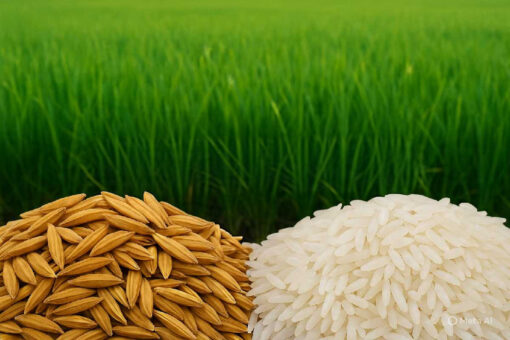
Paddy and Rice
Why the Distinction Matters for India’s Farmers and Global Trade
In the complex worlds of policy and agricultural practice, it is absolutely crucial to distinguish the basic agricultural produce: Paddy.
Often, in the hustle and bustle of India, these fundamental basics are overlooked. So, let’s be clear.
What Exactly is Paddy?
In agriculture, “The term ‘paddy’ refers to rice that is still in its husk. It is the harvested rice grain that has not yet been milled to remove the outer husk.” ()
The farmer grows paddy. Rice is the product obtained only after the husk is separated. This distinction must never be confused in any form of policy or practice.
For the farmer, the goal is simple: to grow enough paddy for family consumption. The surplus is then sold in exchange for money to sustain a livelihood. It is a cereal basic to life, with wheat being the primary alternate, though other choices are available for daily consumption.
The Dignity of the Farmer and Their Choices
Economics must be applied hand-in-hand with social and political objectives in the conduct of the State’s affairs, or the Government as we call it. The dignity of the individual needs to prevail when we discuss the farmer, his produce, and how to make his life better. It fundamentally comes down to the choices the farmer can make at the time of planting.
As producers, farming families take significant risks when they plant their seed or seedlings—sometimes out of necessity, sometimes out of habit. We must create a system that honors and supports these choices.
A Vision for Export: Evacuating Paddy, Not Just Rice
India needs to export 10 million metric tonnes of paddy every year, in addition to rice. Why? The reason is threefold: evacuate, evacuate, evacuate and, in doing so, create an infrastructure to mill rice within importing nations.
This strategy allows India to avoid direct rivalry in the world trade of milled rice. Instead, India can provide a steady supply, allowing rice surpluses from other nations like the USA to dissipate around the world based on natural demand. This market need not be subject to harmful speculation or volatility. Both US and Indian farmers have choices and, based on forecasts, can grow any crop they see fit.
Building Resilient Buffer Stocks Abroad
It is now time to consider that buffer stocks should be held at destination points. Each importing nation should have at least one year’s equivalent of consumption, milled at convenient locations.
The logic behind this is sound: Rice is best milled after at least 9 months to one year of aging. There is more consistency in the safety of rice stored as paddy than in the storage of milled rice, which is best consumed within days or weeks. A household can store about 3 months’ worth of milled rice, but not more without risking infestation. (Note: Insect repellents need not be synthetic – there are natural options that can be approved by regulatory and sanitary/phytosanitary authorities.)
The Practical Advantages of Paddy Export
The logistical benefits are clear:
– Paddy can be exported in bulk using ventilated marine containers by liners.
– Rice has to be bagged, which is more costly and labor-intensive.
The milling industry can export second-hand or first-hand machines to African nations that are importers. Governments can encourage the establishment of free zones as hubs and trading centres, making paddy available to millers at any time, whether in spot or forward markets.
The advantage for India is immense: paddy exports can happen immediately after harvest. The essential aging process can take place during transit and at the destination. This means precious working capital need not be allocated to prolonged storage of paddy by the Government or private traders.
Farmers or traders can evacuate paddy directly to ports or SEZ-based warehousing. A terminal market in rupees can be established with the Forward Markets Commission (with State Government approval) within the customs-bonded premises of ports.
Financing a New Global System
Indian enterprise, through institutions like Exim Bank and NABARD, can extend investment guarantee protection to millers in consuming nations, enabling them to undertake milling locally. Working capital management can be arranged by Indian commercial banks with correspondent relationships abroad, providing up to 80 percent of the value for shipment or storage.
Once the rice is milled, the consumption function is taken care of by local consumers. This elegant system effectively eliminates all consumption-related issues for India.
A Proposal for Leadership
India’s trade relationship with the UAE has always been strong. The Indian Cabinet can pass a resolution for exporting 5 million metric tonnes of paddy – of any quality or variety that the farming community chooses to part with.
When the UAE agrees to hold reserves for itself and for the region, including Africa, all nations prosper. In such a system, Australia and the US can also export their paddy. Rice, with its quality assured, will seamlessly find its way to any part of the consuming world.
This is a vision for a more stable, dignified, and efficient global food system, starting with the simple, crucial distinction between paddy and rice.